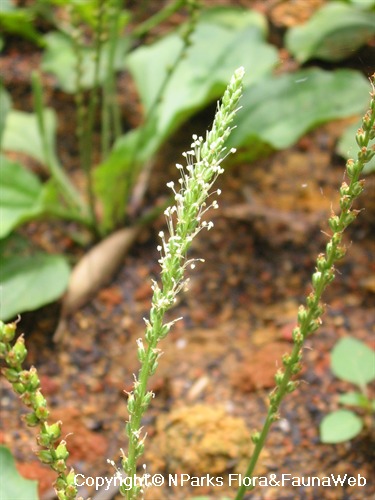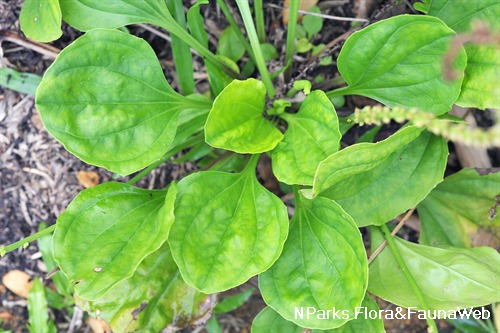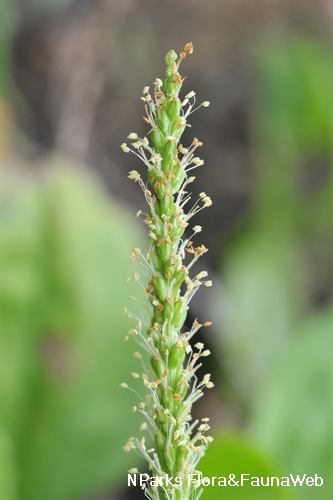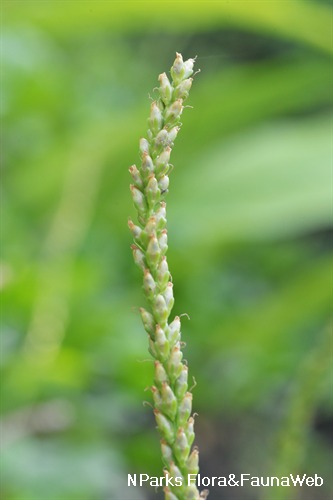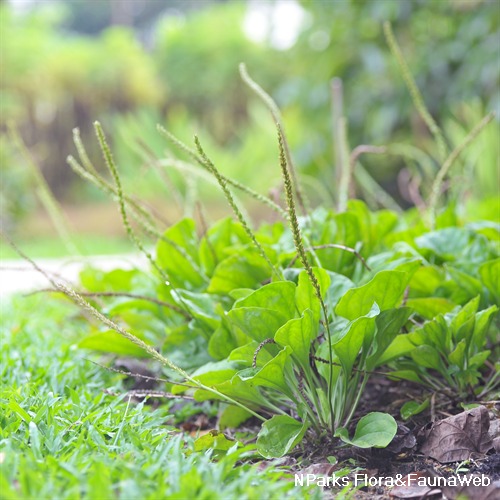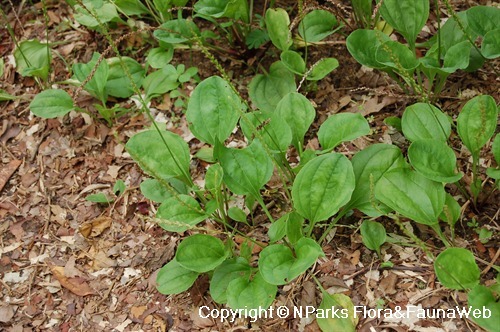
Back
Plantago major
| Family Name: | Plantaginaceae |
| Common Name: | Common Plantain, White-man's Foot, Cart-track-plant, 大车前 |
Name
Classifications and Characteristics
| Plant Division | Angiosperms (Flowering Seed Plants) (Dicotyledon) |
|---|---|
| Plant Growth Form | Herbaceous Plant |
| Lifespan (in Singapore) | Perennial |
| Mode of Nutrition | Autotrophic |
Biogeography
| Native Distribution | Throughout Europe, northern and central Asia |
|---|---|
| Native Habitat | Terrestrial |
| Local Conservation Status | Non-native (Spontaneous (Naturalised)) |
Description and Ethnobotany
| Growth Form | Perennial herb up to 15-45 cm tall. |
|---|---|
| Roots | It has a taproot system. |
| Foliage | Oval-shaped leaves (15 cm long, 10 cm wide) are arranged in a rosette which lies close to the ground. They have a ribbed leaf texture with about 5 prominent veins that lie parallel to each other. |
| Flowers | Small, greenish white flowers are arranged in a long spike inflorescence (15-45 cm long). |
| Fruit | Dry, egg-shaped fruits are known as capsules (3-5 mm long). It splits open horizontally in the middle, releasing 5-16 brown to dark brown, irregularly shaped seeds. |
| Habitat | Can be found in gardens, urban sites, roadsides and other disturbed places with compacted and soggy soil. |
| Cultivation | It grows best in full sun and moist soil, but tolerates partial shade and dry soils. |
| Ethnobotanical Uses | Edible Plant Parts : Edible Leaves, Edible Flowers Food (Herb or Spice): The young leaves are used in salad, steamed and used as a substitute for spinach. Immature inflorescence is also edible, raw or cooked. The leaves, seeds and roots can all be made into an herbal tea. Medicinal: Scientific Evidence of Medicinal Properties In pre-clinical trials, Common Plantain showed pain-relieving (Guillén et al., 2008), anti-cancer (Ozaslan et al., 2007), anti-diabetic (Alarcon-Aguilar et al., 2006), anti-inflammation (Türel et al., 2009), anti-microbial (Hetland et al., 2001), antioxidant (Oto et al., 2011), and cholesterol-lowering properties (Angarskaya & Sokolova, 1963) in animals. Traditional Medicinal Uses Research supports the traditional use of Common Plantain to treat stings, bites, rashes and sunburn, as it may help to relieve pain and reduce inflammation. It is important to note that some therapeutic effects from traditional medicinal uses of plants are not currently supported or verified by scientific research. |
Landscaping Features
| Plant & Rootzone Preference or Tolerance Remarks | Can grow in any type of soil. |
|---|
Fauna, Pollination and Dispersal
| Fauna Pollination Dispersal Associated Fauna | Butterfly Host Plant |
|---|---|
| Seed or Spore Dispersal | Abiotic |
Plant Care and Propagation
| Light Preference | Full Sun |
|---|---|
| Water Preference | Moderate Water |
| Plant Growth Rate | Fast |
| Rootzone Tolerance | Easy to Grow |
| Maintenance Requirements | Low |
| Propagation Method | Seed |
Foliar
| Foliage Retention | Evergreen |
|---|---|
| Mature Foliage Colour(s) | Green |
| Mature Foliage Texture(s) | Smooth |
| Foliar Type | Simple / Unifoliate |
| Foliar Arrangement Along Stem | Rosulate / Rosette |
| Foliar Attachment to Stem | Sessile |
| Foliar Shape(s) | Non-Palm Foliage (Ovate) |
| Foliar Venation | Palmate |
| Foliar Margin | Entire - Wavy / Undulate |
| Foliar Apex - Tip | Rounded |
| Foliar Base | Rounded / Obtuse, Attenuate |
| Leaf Area Index (LAI) for Green Plot Ratio | 4.5 (Shrub & Groundcover - Dicot) |
Floral (Angiosperm)
| Flower Colour(s) | Cream / Off-White |
|---|---|
| Flower Grouping | Cluster / Inflorescence |
| Flower Location | Terminal |
| Inflorescence Type | Spike |
| Flowering Period | Free-Flowering |
| Flowering Habit | Polycarpic |
| Flower Colour(s) Remarks | Greenish white |
Fruit, Seed and Spore
| Fruit Classification | Simple Fruit |
|---|---|
| Fruit Type | Dehiscent Dry Fruit , Capsule |
| Seed Quantity Per Fruit | Several (11-20) |
Image Repository
Others
| Master ID | 1051 |
|---|---|
| Species ID | 5294 |
| Flora Disclaimer | The information in this website has been compiled from reliable sources, such as reference works on medicinal plants. It is not a substitute for medical advice or treatment and NParks does not purport to provide any medical advice. Readers should always consult his/her physician before using or consuming a plant for medicinal purposes. |

